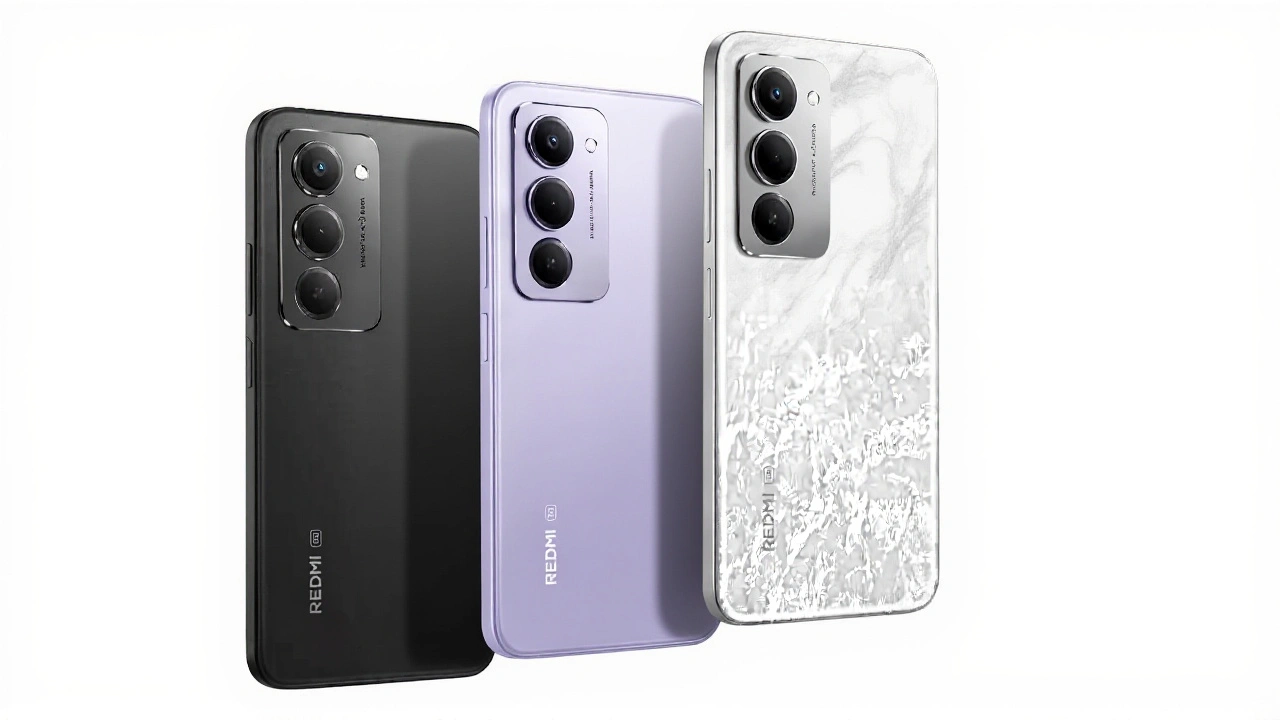When Xiaomi unveiled the Redmi 15 5G in India on , the buzz was palpable. The launch, staged at a glossy event in Bengaluru, was led by Lei Jun, Xiaomi’s charismatic CEO, who pitched the phone as a “segment game‑changer”. At a starting price of ₹14,998, the device promises Snapdragon‑level performance, a 7,000 mAh battery and a 144 Hz display – all under the coveted ₹15,000 ceiling.
Why the Redmi 15 5G matters
India’s mid‑range market has been a battleground for Chinese brands, Samsung and local OEMs alike. By slipping a flagship‑grade Snapdragon 6s Gen 3 chip – supplied by Qualcomm – into a sub‑₹15k handset, Xiaomi is trying to rewrite the performance‑price equation. The company claims it’s the only phone in this price band offering that level of chipset muscle.
Hardware specs at a glance
- Display: 6.9‑inch FHD+ Adaptive Sync panel, 1080 × 2340 px, 144 Hz refresh, TÜV Rheinland triple‑certified for eye comfort.
- Processor: Qualcomm Snapdragon 6s Gen 3, octa‑core, 2.9 GHz peak.
- Memory: 6 GB or 8 GB RAM, virtual RAM extension up to 16 GB; storage 128 GB or 256 GB UFS 2.2.
- Battery: 7,000 mAh Li‑Polymer with Si‑C (silicon‑carbon) tech, 33 W fast charge, 18 W reverse charge.
- Cameras: Dual rear – 50 MP (f/1.75) + 2 MP depth; front 8 MP (f/2.2) with AI‑enhanced modes.
- OS: Android 15, Xiaomi HyperOS 2.0, 2‑year OS upgrades, 4‑year security patches.
- Durability: IP64 dust‑water resistance, quad‑curved glass, side fingerprint sensor.
Battery life that actually lasts
Seven thousand milliamp‑hours sounds like a number you’d expect on a rugged tablet, not a pocket phone. Xiaomi’s internal tests claim up to 55 hours of talk time, 108 hours of standby and a full 25 hours of video playback. In real‑world “light daily use” – think checking messages, occasional streaming and a few social posts – the phone should comfortably cross the 2.26‑day mark before needing a charge.
Even when the gauge dips to 1 %, the device can still push out a 59‑minute call or keep the music playing for another 7.5 hours. That sort of endurance is rare in this segment and could be a decisive factor for commuters and students who can’t afford a charger at every coffee shop.
Camera and software – AI on a budget
The 50 MP primary sensor uses a large f/1.75 aperture, promising decent low‑light performance. Xiaomi bundles AI tools like AI Erase (remove unwanted objects), AI Sky (replace dull skies) and AI Beauty, alongside classic film filters. While the front‑facing 8 MP shooter won’t win awards, it’s more than adequate for video calls and quick snaps.
Running on Android 15 with HyperOS 2.0, the UI feels leaner than the older MIUI skin. Users get a promise of two years of major OS upgrades – meaning Android 16 should land in 2027 – and four years of monthly security patches, a timeline that aligns with the best‑in‑class Android flagship promises.

Pricing strategy and market positioning
At ₹14,998, the Redmi 15 5G undercuts many of its rivals, including Samsung’s Galaxy A54 (≈₹20,000) and realme’s 8 Pro (≈₹17,500). Xiaomi’s marketing team frames the device as a “punch‑above‑its‑weight” offering, targeting first‑time 5G buyers, college students and budget‑conscious gamers who crave smooth visuals without splurging.
To back up the claim, the phone has undergone 500,000 power‑button presses, 3,000 compression tests, 300 roller tests and 20,000 charging‑port endurance cycles. Those numbers sound like something a flagship would brag about, not a low‑cost handset.
Industry reactions
"The Snapdragon 6s Gen 3 in a sub‑₹15k phone is a bold move," said Arun Mehta, senior analyst at Counterpoint Research. "If the battery life lives up to the lab numbers, Xiaomi could force competitors to rethink their own mid‑range roadmaps."
Conversely, a consumer‑rights group warned that “large batteries can introduce heat issues if not properly managed,” urging buyers to monitor temperature during intensive gaming sessions.
What’s next for Xiaomi in India?
Following the August launch, Xiaomi plans to roll the Redmi 15 5G out across major e‑commerce platforms and its own Mi Stores by the end of September. The company also hinted at a “software‑first” update pipeline that could bring new AI camera modes throughout 2025.
In the longer view, Xiaomi’s aggressive pricing could push rivals to accelerate their own 5G rollouts, potentially widening the affordable 5G ecosystem in India – a win for consumers, but a challenge for profit margins.
Frequently Asked Questions
How does the Redmi 15 5G compare to the Galaxy A54?
The Redmi 15 5G offers a Snapdragon 6s Gen 3 processor, a larger 7,000 mAh battery and a 144 Hz display, while the Galaxy A54 relies on an Exynos chip, a 5,000 mAh battery and a 60 Hz screen. Both sit around the ₹15k‑₹20k price range, but Xiaomi’s model provides higher refresh rates and longer endurance on paper.
Will the 33 W charger fully power the 7,000 mAh battery?
Yes, the bundled 33 W charger can refill the 7,000 mAh cell from 0 % to 100 % in roughly 2‑2.5 hours, according to Xiaomi’s own tests. It’s not as fast as the 65 W chargers found on premium flagships, but it’s a solid trade‑off for the price point.
Is the IP64 rating sufficient for everyday use?
IP64 protects against splashing water and dust ingress, which covers most accidental spills and rain. However, it’s not a full‑proof waterproof rating, so submerging the device or exposing it to heavy rain for extended periods isn’t advisable.
What software updates can buyers expect?
Xiaomi promises two major Android OS upgrades – meaning the Redmi 15 5G should see Android 16 in 2027 – and four years of security patches, keeping the phone relatively future‑proof for a budget device.
Will the large battery affect the phone’s weight?
At 217 grams, the Redmi 15 5G is heavier than many 6‑7 inch phones in the same class, but the weight is evenly distributed thanks to its quad‑curved glass design. Most users find it comfortable for one‑hand use after a short adjustment period.






Redmi 15 5G looks slick, but at ₹15k you could get a better camera for the same price 😊.
The integration of a Snapdragon 6s Gen 3 within a sub‑₹15k envelope represents a paradigm shift in cost‑performance elasticity, yet the thermal envelope remains insufficiently quantified. Moreover, the 7,000 mAh construct, while impressive, introduces a mass penalty that could exacerbate thermal throttling under sustained 5G bursts.
Wow, this phone is practically a beast in a budget’s clothing! A 144 Hz refresh rate paired with a massive 7,000 mAh battery is like giving your gaming rig a caffeine shot. Imagine streaming, gaming, and video‑calling for days without hunting for a charger – pure freedom! Xiaomi just dropped a bombshell that could rewrite the whole mid‑range playbook.
It’s an interesting mix – the specs are strong, but the added weight from the big battery might be a concern for some users. The IP64 rating is decent for everyday splashes, though not fully waterproof. Overall, it seems like a solid trade‑off for the price.
From a perspective of value engineering, the Redmi 15 5G epitomises an admirable equilibrium between performance and affordability. The commitment to two major Android OS upgrades underscores Xiaomi’s dedication to long‑term user satisfaction. I am confident that this offering will catalyse broader 5G adoption among budget‑conscious consumers.
The Redmi 15 5G arrives at a moment when the Indian mid‑range arena is particularly crowded, yet its specifications set it apart in a compelling manner. At the heart of the device lies the Snapdragon 6s Gen 3, a chipset that, while historically reserved for premium flagships, has been down‑clocked to balance thermals and power consumption. Coupled with up to 8 GB of RAM and a virtual extension to 16 GB, the phone promises multitasking fluidity that rivals many higher‑priced competitors. The 6.9‑inch FHD+ Adaptive Sync display, ticking at 144 Hz, provides a visual experience where motion blur is dramatically reduced, benefiting both gamers and media consumers. In terms of endurance, the 7,000 mAh battery is a noteworthy engineering feat, offering the potential for more than two days of moderate usage without the need for a recharge. Xiaomi’s inclusion of Si‑C technology in the battery architecture further enhances charge acceptance rates while mitigating heat generation during fast charging cycles. Speaking of charging, the bundled 33 W charger can replenish the sizable cell in approximately two to two‑and‑a‑half hours, a respectable duration given the battery’s capacity. The camera suite, featuring a 50 MP primary sensor with an f/1.75 aperture, is well‑suited for daylight photography, though low‑light performance may still lag behind more specialized image‑processing modules. The supplementary AI tools, such as AI Erase and AI Sky, add creative flexibility for users who enjoy post‑capture editing without resorting to third‑party apps. Connectivity options include full 5G band support, which, in conjunction with the HyperOS layer built atop Android 15, ensures a seamless integration of network capabilities and user‑interface refinement. From a durability standpoint, the IP64 rating offers reasonable protection against dust ingress and water splashes, though users should remain cautious about submerging the device. The device’s weight, at 217 grams, is slightly higher than many contemporaries, a trade‑off that many may accept in exchange for the extended battery life. Pricing at ₹14,998 positions the phone aggressively low, potentially forcing rivals to re‑evaluate their component sourcing strategies to remain competitive. Industry analysts have already noted that such a price‑to‑performance ratio could accelerate the adoption of 5G services among students and first‑time users. Ultimately, while the Redmi 15 5G may not be flawless, its blend of high‑refresh‑rate display, robust chipset, and unprecedented battery capacity makes it a noteworthy contender in the budget segment.
All this hype is just a distraction from the fact that cheap phones are engineered to become e‑waste faster – buy a durable device or else 😒.
Sure, because the “real” reason Xiaomi slaps a massive battery in is to keep us glued to their data farms while we binge‑watch, right? 🙄
Indeed, the thermal envelope is a mere footnote in the grand tapestry of cost‑performance elasticity, one might say the real challenge is convincing budget shoppers that price tags can be intellectually stimulating.
What they don’t tell you is that the 5G chips are stealthily gathering location data, and the huge battery just ensures the device stays on long enough to harvest it.
Hey, I get the worries, but the extra battery life does mean fewer charging trips and less exposure to those pesky charging stations that could be compromised.
Oh wow… another “budget flagship”-as if we haven’t seen this alchemy before; the market is a grand illusion, isn’t it? LOL!!!
For clarity, the IP64 rating protects against splashes but not full immersion – keep it dry when possible 😊.
To assist prospective buyers, it may be useful to compare the Redmi 15 5G’s specification matrix against the Samsung Galaxy A54, focusing on processor architecture, display refresh rate, and battery capacity, thereby enabling an informed purchase decision.
That’s an excellent suggestion; perhaps we could also include a brief side‑by‑side visual of the two devices’ display quality to further aid decision‑making.